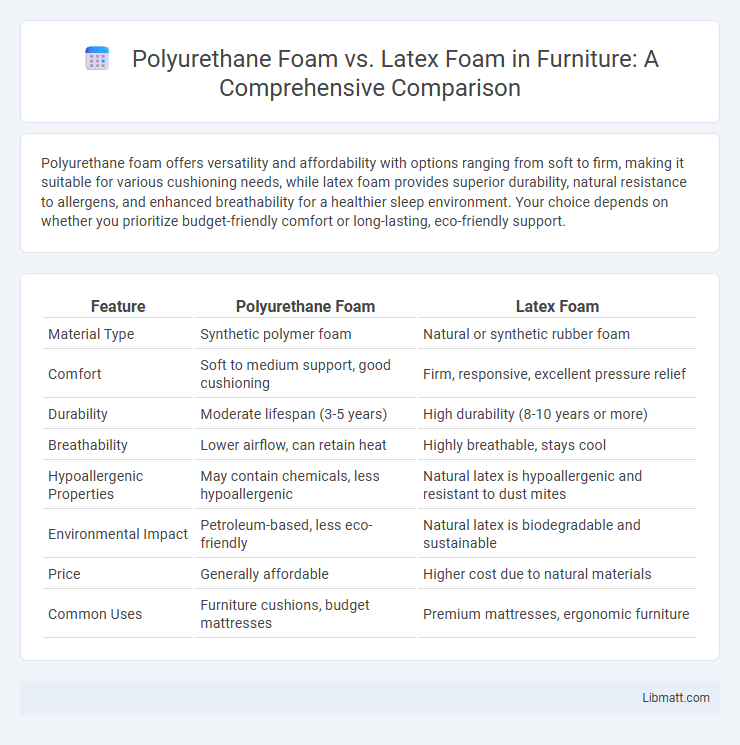Polyurethane foam offers versatility and affordability with options ranging from soft to firm, making it suitable for various cushioning needs, while latex foam provides superior durability, natural resistance to allergens, and enhanced breathability for a healthier sleep environment. Your choice depends on whether you prioritize budget-friendly comfort or long-lasting, eco-friendly support.
Table of Comparison
| Feature | Polyurethane Foam | Latex Foam |
|---|---|---|
| Material Type | Synthetic polymer foam | Natural or synthetic rubber foam |
| Comfort | Soft to medium support, good cushioning | Firm, responsive, excellent pressure relief |
| Durability | Moderate lifespan (3-5 years) | High durability (8-10 years or more) |
| Breathability | Lower airflow, can retain heat | Highly breathable, stays cool |
| Hypoallergenic Properties | May contain chemicals, less hypoallergenic | Natural latex is hypoallergenic and resistant to dust mites |
| Environmental Impact | Petroleum-based, less eco-friendly | Natural latex is biodegradable and sustainable |
| Price | Generally affordable | Higher cost due to natural materials |
| Common Uses | Furniture cushions, budget mattresses | Premium mattresses, ergonomic furniture |
Introduction to Polyurethane and Latex Foam
Polyurethane foam, derived from petrochemical products, offers excellent durability and cushioning properties, making it ideal for furniture, bedding, and insulation. Latex foam, made from natural or synthetic rubber, provides superior elasticity, breathability, and hypoallergenic qualities, favored in mattresses and pillows. Understanding the chemical composition and source differences between polyurethane and latex foam is crucial for selecting the right material based on comfort, support, and environmental factors.
Material Composition and Manufacturing Process
Polyurethane foam is synthesized through a chemical reaction between polyols and diisocyanates, resulting in a versatile, lightweight material with open or closed-cell structures. Latex foam, derived from natural rubber or synthetic latex, undergoes a process like Dunlop or Talalay, where latex suspension is whipped and vulcanized to form a resilient, breathable foam. Your choice depends on whether you prioritize the synthetic adaptability of polyurethane or the natural elasticity and eco-friendliness of latex.
Comfort and Support Comparison
Polyurethane foam offers firm support with moderate comfort, making it ideal for those seeking a balance between cushioning and structural resilience. Latex foam provides superior comfort through its natural elasticity and responsiveness, adapting closely to your body for pressure relief and enhanced support. Choosing between the two depends on whether you prioritize contouring comfort or durable support in your sleep or seating experience.
Durability and Longevity
Polyurethane foam typically offers moderate durability, lasting around 5 to 7 years under regular use, while latex foam is known for superior longevity, often maintaining its shape and support for 10 to 15 years or more. Latex foam's natural resistance to sagging and denting contributes to its extended lifespan, making it ideal for high-use applications. Polyurethane foam may degrade faster due to its synthetic composition, especially under constant pressure and moisture exposure.
Breathability and Temperature Regulation
Polyurethane foam generally offers lower breathability compared to latex foam, as its closed-cell structure can trap heat and moisture. Latex foam features an open-cell design and inherent natural ventilation channels that promote superior airflow, resulting in better temperature regulation and a cooler sleep environment. This makes latex foam more suitable for individuals seeking enhanced breathability and moisture-wicking properties in mattresses or cushions.
Allergen and Chemical Considerations
Polyurethane foam often contains flame retardants and volatile organic compounds (VOCs) that may trigger allergies or respiratory sensitivities in some individuals. Latex foam, especially natural latex, tends to be hypoallergenic and resistant to dust mites, molding a healthier sleep environment for those with allergies. Your choice between these foams should consider potential chemical exposure and allergen risks to support better overall indoor air quality and comfort.
Environmental Impact and Sustainability
Polyurethane foam often relies on petroleum-based materials, leading to higher carbon emissions and non-biodegradability, whereas latex foam, especially natural latex, is derived from rubber tree sap, making it more renewable and biodegradable. Your choice of latex foam supports sustainable harvesting practices that reduce deforestation and promote healthier ecosystems. Despite polyurethane's durability, latex foam offers a more environmentally responsible option for eco-conscious consumers seeking sustainable comfort solutions.
Cost Differences and Value for Money
Polyurethane foam generally costs less per cubic foot compared to latex foam, making it a more budget-friendly option for mattresses and upholstery. Latex foam, although more expensive upfront due to its natural or synthetic origins, offers superior durability, hypoallergenic properties, and pressure relief, often translating to longer-lasting value for money. Consumers seeking cost efficiency may prefer polyurethane foam, while those prioritizing longevity and comfort tend to find latex foam's higher price justified by its performance benefits.
Ideal Applications and Suitability
Polyurethane foam is ideal for applications requiring high density and firm support, such as furniture cushions and insulation panels, due to its durability and cost-effectiveness. Latex foam offers superior elasticity and breathability, making it suitable for mattresses and pillows where comfort and pressure relief are priorities. Your choice between these foams should reflect the specific needs of durability, comfort, and environmental factors in each application.
Choosing the Right Foam for Your Needs
Polyurethane foam offers excellent support and durability, making it ideal for budget-friendly mattresses and furniture with moderate comfort requirements. Latex foam provides superior elasticity, natural hypoallergenic properties, and enhanced breathability, suited for those seeking eco-friendly and responsive cushioning. Evaluate factors such as firmness preference, allergen sensitivity, and environmental impact to choose the right foam for your specific needs.
polyurethane foam vs latex foam Infographic

 libmatt.com
libmatt.com